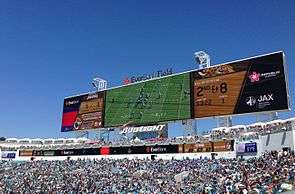Jacksonville Jaguars
| Jacksonville Jaguars | |||||
|---|---|---|---|---|---|
|
| |||||
|
Established November 30, 1993[1] First season: 1995 Play in and headquartered at TIAA Bank Field Jacksonville, Florida | |||||
| |||||
| League/conference affiliations | |||||
|
National Football League (1995–present)
| |||||
|
Current uniform | |||||
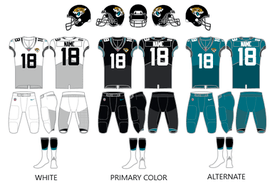 | |||||
| Team colors | |||||
| Mascot | Jaxson de Ville | ||||
| Personnel | |||||
| Owner(s) | Shahid Khan | ||||
| President | Mark Lamping | ||||
| General manager | David Caldwell | ||||
| Head coach | Doug Marrone | ||||
| Team history | |||||
| |||||
| Team nicknames | |||||
| |||||
| Championships | |||||
|
League championships (0) | |||||
| Conference championships (0) | |||||
|
Division championships (3) | |||||
| Playoff appearances (7) | |||||
| Home fields | |||||
| |||||
The Jacksonville Jaguars are an American professional football franchise based in Jacksonville, Florida. The Jaguars compete in the National Football League (NFL) as a member club of the American Football Conference (AFC) South division. The team plays its home games at TIAA Bank Field.
The Jaguars and the Carolina Panthers joined the NFL as expansion teams for the 1995 season. Since their inception, the Jaguars have won division championships in 1998 and 1999 (as members of the now-defunct AFC Central) and 2017 (as members of the AFC South) and have qualified for the playoffs seven times, most recently in 2017 after a ten-season playoff drought.[4]
From their inception until 2011, the Jacksonville Jaguars' majority owner was Wayne Weaver. The team was then purchased by Pakistani-born businessman Shahid Khan for an estimated $770 million.[5][6] In 2015, Forbes estimated the team value at $1.48 billion.[7]
Franchise history
1989–1994
%2C_Capt._Dennis_E._FitzPatrick_shakes_hands_with_Jacksonville_Jaguar_owner_Wayne_Weaver.jpg)
In 1989, the prospective ownership group Touchdown Jacksonville! was organized. The group initially included future Florida Governor Jeb Bush and Jacksonville developer Tom Petway, and came to be led by shoe magnate Wayne Weaver, founder of Nine West. In 1991, the NFL announced plans to add two expansion teams in 1994 (later delayed until 1995), its first expansion since the 1976 addition of the Seattle Seahawks and the Tampa Bay Buccaneers. Touchdown Jacksonville! announced its bid for a team, and Jacksonville was ultimately chosen as one of five finalists, along with Charlotte, St. Louis, Baltimore, and Memphis.[8]
Jacksonville was considered the least likely expansion candidate for several reasons. The Jacksonville metropolitan area and television market were smaller than those of nearly every team in the league.[8] Although Jacksonville was the 15th largest city in the nation at the time (It has since grown to become the 11th-largest), it has always been a medium-sized market because the surrounding suburbs and rural areas are far smaller than the city itself. There were 635,000 people in Jacksonville proper according to the 1990 census, but only 900,000 people in the metropolitan area.[9][10] Additionally, the Gator Bowl was outdated, and the ownership group struggled to negotiate a lease with the city. The troubled negotiations over the Gator Bowl lease led the ownership group to withdraw from the NFL expansion bidding in July 1993.[8]
Charlotte was awarded the first franchise – the Carolina Panthers – in October 1993. Surprisingly, the naming of the second expansion city was delayed a month. Most pundits speculated that the delay was made to allow St. Louis to shore up its bid. At the time, St. Louis was considered the favorite for the second franchise, with Baltimore's three bids also considered strong. However, in a surprising move, the NFL owners voted 26–2 in favor of awarding the 30th franchise to Jacksonville.[8]
After the Gator Bowl game on December 31, 1993, the old stadium was essentially demolished and replaced with a reinforced concrete superstructure. All that remained of the old stadium was the west upper concourse and a portion of the ramping system.[11] To accommodate construction, the 1994 and 1995 games of "The World's Largest Outdoor Cocktail Party" were split between the home fields of Florida and Georgia, and the 1994 Gator Bowl was played at Ben Hill Griffin Stadium in Gainesville.[12]
1995–2002
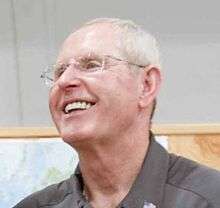
In January 1994 Wayne Weaver chose Tom Coughlin as the first-ever head coach of the Jaguars. Coughlin had worked in the NFL as a position coach, but he had been neither a head coach nor a coordinator in the NFL.[13]
The Jaguars' hiring of Coughlin contrasted with the hiring moves made by their fellow expansion team. The same month that Weaver hired Coughlin as his head coach, Carolina Panthers owner Jerry Richardson went a more conventional route and hired former Buffalo Bills general manager Bill Polian as the Panthers' first GM (the Panthers' head coach, Dom Capers, would not be hired until a full year after Coughlin). As it emerged that Weaver had no intention of hiring a general manager, it became apparent that Coughlin would have most of the authority regarding hiring decisions. Coughlin spent his year as "head coach without a team"[13] preparing for the personnel moves that would come from the expansion draft, free agency, and the rookie draft in the spring of 1995.
1995
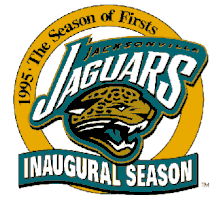
Along with the Carolina Panthers, the Jacksonville Jaguars entered the NFL as the first expansion teams in almost 20 years. Both teams participated in the 1995 NFL expansion draft, with the Jaguars taking Steve Beuerlein with the first pick. Beuerlein quickly lost his starting job to former Green Bay Packers backup Mark Brunell. The Jaguars finished their inaugural season with a record of 4–12. Both the Jaguars and the Panthers (7–9) broke the previous record for most wins by an expansion team (3) set by the Cincinnati Bengals in 1968.[14] The inaugural season featured many of the players who would lead Jacksonville into the playoffs in the team's next four seasons, including quarterback Mark Brunell (acquired in a draft day trade from Green Bay), offensive lineman Tony Boselli (drafted with the 2nd pick overall in the 1995 NFL Draft) running back James Stewart (also drafted in 1995), and wide receiver Jimmy Smith (signed as a free agent).
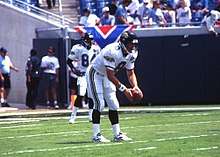
The team played its first regular season game at home in front of a crowd of 72,363[15] on September 3, 1995, a 10–3 loss against the Houston Oilers. The team picked up its first win in Week 4 as the Jaguars defeated the Oilers 17–16 on October 1 in Houston. The next week against the Pittsburgh Steelers, the Jaguars earned their first home win by defeating the eventual AFC Champions 20–16. The team's other two wins came in a season sweep of the Cleveland Browns including a Week 17 24–21 victory sealed by a Mike Hollis 34-yard field goal[16] in the Browns' final game before the team relocated to Baltimore and was renamed the Ravens.
1996
Jacksonville's 1996 season was a marked success as they won six of their last seven games of the season and finished with a record of 9–7. Quarterback Mark Brunell threw for over 4,000 yards and wide receivers Keenan McCardell and Jimmy Smith each accumulated over 1,000 receiving yards. In the team's final game of the regular season against the Atlanta Falcons, needing a win to earn a playoff berth, the Jaguars caught a bit of luck when Morten Andersen, one of the most accomplished kickers in NFL history, missed a 30-yard field goal with less than a minute remaining that would have given the Falcons the lead.[17] The Jaguars clinched the fifth seed in the AFC playoffs.
The Jaguars visited the Buffalo Bills in their first playoff game in franchise history. Despite being a heavy underdog, the Jaguars won 30–27, and knocked Buffalo quarterback Jim Kelly out of what would turn out to be the last game of his career. Their next game was on the road against the Denver Broncos, who had earned the AFC's top seed with a 13–3 record and were widely regarded as the best team in the AFC, if not the NFL. While the Broncos scored two touchdowns early in the game, after the first quarter, the Jaguars largely dominated. In what is often regarded as one of the three biggest upsets in NFL playoff history,[18][19][20] the Jaguars defeated the Broncos by the same score as the previous week against the Bills, 30–27. Upon their return home, the Jags were greeted by an estimated 40,000 fans at the stadium. Many of these fans had watched the game on the stadium JumboTron displays and had stayed into the early hours of the morning when the team arrived. In the AFC Championship Game, the Jaguars miracle season came to an end, as they lost 20–6 to the New England Patriots, in Foxboro. Their fellow second-year NFC expansion team, the Carolina Panthers, also got to their conference championship game, where they lost 30–13 to the eventual Super Bowl champion Green Bay Packers.[21]
1997–99
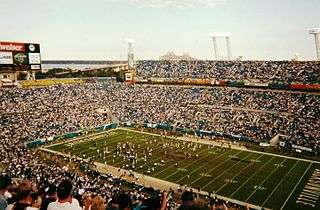
In 1997, the franchise's third season, the Jaguars and the Steelers both finished the season with an 11–5 record, tops in the AFC Central Division. Pittsburgh won the division in a tiebreaker as a result of having higher net in division games than Jacksonville.[22] As a result, the Jaguars settled for 2nd place in the division, a Wild Card berth and, for the second straight year, the 5th seed in the AFC playoffs. The Jags postseason would end quickly as they fell in their first game, a 42–17 defeat against the eventual Super Bowl champion Denver Broncos at Mile High Stadium. The Broncos, led by Terrell Davis, ran at will against the Jaguars, rushing for 5 touchdowns and over 300 yards.[23]
In 1998, the Jaguars again finished 11–5 and won their first AFC Central Division title. The team became the first NFL expansion team to make the playoffs three times in its first four seasons of play. In the Wild Card Round, the Jaguars hosted their first home playoff game, a 25–10 win over the New England Patriots. The team's season ended the next week in the Divisional Round as the New York Jets defeated the Jaguars 34–24.[24]
In 1999, the Jaguars compiled a league best 14–2 regular season record, the best record in franchise history. The team's two losses were to the Tennessee Titans. The Jaguars won the AFC Central Division for the second straight year and clinched the #1 seed in the AFC. The Jaguars hosted the Miami Dolphins in the AFC Divisional playoffs, a 62–7 victory in what would be Dan Marino and Jimmy Johnson's last NFL game. Jacksonville's 62 points and 55-point margin are the second most ever in NFL playoff history, and Fred Taylor's 90-yard run in the first quarter is the longest ever in an NFL playoff game.[25]
The Jaguars' bid for a Super Bowl title came to an end the next week in the AFC championship game. The Jags fell at home to the Titans 33–14 in a game that the Jaguars led 14–10 at halftime, before allowing 23 unanswered points in the 2nd half. The Jaguars finished the 1999 season 15–3, with all three of their losses coming against the Titans. The loss marked the end of an era that saw the Jaguars make the playoffs in four of the team's first 5 years and would be the team's last playoff appearance until the 2005 season.[26]
2000–02
The Jaguars struggled during this period, due in part to salary cap problems.[27] In the 2000 season, veteran quarterback Mark Brunell and young running back Fred Taylor led the squad through a painful 7–9 season. The Jaguars finished with records of 6–10 in both the 2001 and 2002 seasons.
After the 2002 season, head coach Tom Coughlin was fired after eight seasons, leading the Jaguars to a total record of 68–60 and four trips to the playoffs. The 2002 season also marked the last full season for Jaguars quarterback Mark Brunell, who was benched in the third game of 2003 in favor of Byron Leftwich. Brunell piled up over 25,000 yards as a Jaguar and earned three trips to the Pro Bowl. In 2002 the NFL split up the two conferences into four divisions, sending the Jacksonville Jaguars to the AFC South. This put them in the same division as the Indianapolis Colts, Tennessee Titans, and the expansion Houston Texans.[28]
2003–2011
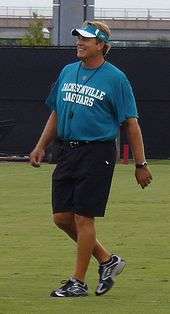
2003–05
In 2003, the Jaguars hired Jack Del Rio as head coach. Del Rio was a linebacker during the late 80s and early 90s before retiring. He was formerly the Carolina Panthers' defensive coordinator, bringing the team's defensive ranking from 30th to second. Prior to that, Del Rio was the Baltimore Ravens linebackers coach, participating in that capacity on the Ravens' record setting championship 2000 defense. The Jaguars selected quarterback Byron Leftwich with the seventh pick of the NFL draft. The Jaguars had high hopes for their new quarterback. The team had many failures and heartbreaking moments, ending the 2003 season at 5–11 and missing the playoffs for the fourth consecutive season. Despite resolving their salary cap problems, the team's rebuilding was clearly taking longer than expected.
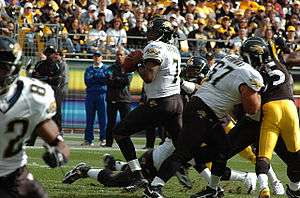
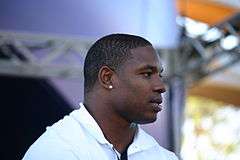
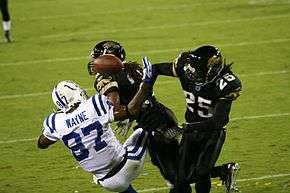

The 2004 season, the 10th season of the Jaguars franchise, resulted in a 9–7 record, their first winning season since 1999, with road victories against the Green Bay Packers at Lambeau Field and the Indianapolis Colts at the RCA Dome. The Jaguars' defense was a strong suit, as it included two Pro Bowl players, defensive tackles Marcus Stroud and John Henderson. Josh Scobee was selected in the 5th round of the 2004 NFL Draft and became a dominant placekicker for the Jaguars setting multiple franchise records.[29] Byron Leftwich enjoyed a solid year in 2004, helped by strong performances from holdovers Fred Taylor and Jimmy Smith. Unfortunately, Taylor sustained a season-ending injury at Green Bay. The very next week the Jaguars fell to the Houston Texans, which would ultimately eliminate them from playoff contention.[30]
The 2005 Jaguars hoped to challenge the Colts for the division title. However, due to their scintillating 13–0 start, including two victories against the Jaguars, the Colts easily clinched the AFC South title. With a 12–4 record, the Jaguars earned a wild card and their first playoff appearance since 1999. While the Jaguars managed to win key games in 2005, nine of their final ten games were against opponents with losing records. Though these games were wins, key players Byron Leftwich, Mike Peterson, Akin Ayodele, Paul Spicer, and Rashean Mathis were hurt during this stretch. The Jaguars ended the season losing 28–3 to the two-time defending champion New England Patriots on January 7, 2006 in the AFC wild card playoff round.[31]
2006
Jacksonville looked like a team on the rise coming off of their 12–4 season, and was considered a playoff contender entering the season. But injuries plagued the team. Reggie Hayward, Greg Jones, Donovin Darius, Byron Leftwich, and Mike Peterson all suffered season-ending injuries. Marcus Stroud, Matt Jones, Paul Spicer, and Fred Taylor also faced injuries during the season. The team started off 2–0, defeating the Dallas Cowboys (earning the NFL's highest winning percentage on opening days at .750 with a record of 9–3), and shutting out the defending champs Pittsburgh Steelers. But the team lost its next two games, and suffered embarrassing losses to the Houston Texans over the course of the season (Jacksonville has struggled against the Texans since Houston entered the league in 2002). They missed the playoffs with an 8–8 record, but there were some positives, in particular an impressive rookie season by their second-round draft pick, running back Maurice Jones-Drew.[32]
2007
In the 2007 NFL Draft, the Jaguars used their first-round pick (21st overall) to select Florida safety Reggie Nelson. On June 15, 2007, the Jaguars released veteran strong safety Donovin Darius, who had seen diminished playing time in previous years due to mounting injuries. On August 31, 2007, the Jaguars announced that long time back-up quarterback David Garrard would start for the team, ahead of former first round draft pick Byron Leftwich, who was released in the team's final roster cuts. Garrard led the Jaguars to an 11–5 record and a wild card spot in the playoffs. The Jaguars defeated the Pittsburgh Steelers 31–29 to win their first playoff game in almost eight years and their first road playoff win since 1997. It was also the first time in the 50+ year history of the Steelers that they had been beaten twice at home by the same team in the same season. However, in the divisional round, the Jaguars fell to the then-undefeated New England Patriots; the teams were tied at halftime, but the Patriots pulled ahead and won 31–20. Tom Brady completed 26 of 28 passes in this game, being pressured by the Jaguars' defense only once, on the first play. This game, more than any other, gave the Jaguars' front office a strong desire to upgrade the pass rush during the offseason.
The team's offense in 2007 was largely a run-first offense, with Maurice Jones-Drew and Fred Taylor each putting up a lot of yards. David Garrard, however showed to be an efficient passer in 2007, throwing only 3 interceptions.
2008
The 2008 season began with high expectations for the Jaguars. The team acquired free agent wide receiver Jerry Porter and rookie defensive ends Quentin Groves of Auburn and Derrick Harvey of Florida to address the team's most glaring needs. (Porter was released the following year and Groves was traded to Oakland in 2010.) Journalists including ESPN.com's Kevin Seifert predicted the Jaguars were poised to make a Super Bowl run.[33]
However, the Jaguars failed to live up to those expectations, struggling to a 5–11 finish, the franchise's worst record since 2003. The team's struggles were in part, the result of a rash of injuries to the team's offensive line. The Jaguars lost starting guards Vince Manuwai and Maurice Williams for the season within the first quarter of the opening game. Tackle Richard Collier's career ended in early September when he was brutally attacked and shot 14 times.[34] Center Brad Meester missed the first two months of the season and guard Chris Naeole, signed to the roster mid-season in response to these injuries, was injured in pregame warmups before playing a single snap. The 2008 season marked the end of running back Fred Taylor's 11-year career as a Jaguar. Taylor, who is considered to be one of the greatest Jaguars in the history of the franchise, rushed for over 10,000 yards during his tenure with Jacksonville and earned one trip to the Pro Bowl. In 2009, he signed with the New England Patriots. Taylor's departure opened up the door for Maurice Jones-Drew to become the team's feature running back. In 2011, Taylor signed a one-day contract so he could retire as a Jaguar.[35]
2009–2010
The Jaguars hoped to begin a new era in 2009 under their first-ever general manager, Gene Smith. Smith made his mark early on in the 2009 NFL Draft by acquiring talent such as Eugene Monroe, Terrance Knighton, Derek Cox, Eben Britton and Mike Thomas, who all made significant contributions in their rookie years. The Jaguars finished off this season 7–9 and did not manage to make the playoffs. In the offseason, the Jaguars parted ways with veteran players John Henderson and Reggie Hayward as part of the team's "youth movement".
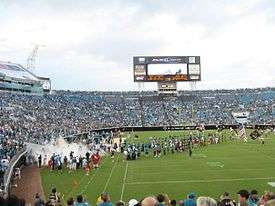
However, 2009 also saw the team's attendance numbers plummet, leading to television blackouts and speculation that the team could eventually be moved or sold.[36] 2009 marked a low point, with the team's attendance averaging around 50,000,[37] causing seven of the eight home games to be blacked out, and leading NFL commissioner Roger Goodell to address the issue with owner Wayne Weaver.[36][38] Jacksonville is one of the league's smallest markets, though its stadium is relatively large; since 2005 the team has covered nearly 10,000 of the stadium's 73,000 total seats with tarp in order to lower the stadium's official capacity to a more typical size and reduce blackouts.[39] 73,000 total seats still ranks as one of the largest in the NFL. From 2008 the team further suffered from the late-2000s recession, which hit Florida particularly hard, and structural changes within the NFL that disadvantage teams in smaller markets.[36]
In 2010, to address this issue, the team and the City of Jacksonville undertook several measures aimed at ensuring the franchise's continued viability in Jacksonville. Supporters began the "Team Teal" drive to drum up ticket sales.[40][41] The city negotiated a five-year, $16.6 million naming rights deal with Jacksonville-based EverBank to rename the stadium EverBank Field.[36][42] As a result, the Jaguars' attendance increased dramatically in 2010. While attendance figures were stagnant for most of the NFL, Jacksonville saw an increase of 36.5%, by far the highest in the league, and had none of their home games blacked out.[43][44]
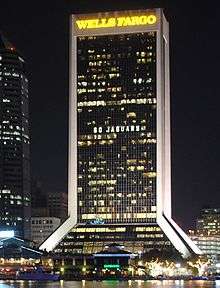
The 2010 season proved a big year for the Jaguars on the field as well. Running back Maurice Jones-Drew emerged as second in the league in rushing yards and David Garrard threw for 23 touchdowns, a franchise record. Marcedes Lewis went to his first Pro Bowl and the Jags had one of the best young defensive tackle pairs with Terrance Knighton and rookie Tyson Alualu.[45] Josh Scobee set a team record with a 59-yard field goal to beat the Indianapolis Colts. Heading into December, Jacksonville was at the top of the AFC South and in playoff contention. In Week 15, they lost to Indianapolis, 34–24, which placed the Colts back atop the AFC South. The Jaguars lost their last two games, placing themselves out of playoff contention. They finished the season 8–8.
2011
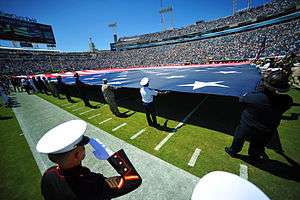
In the 2011 NFL draft, the Jaguars traded a first and a second round pick in order to move up to the 10th pick and select Missouri quarterback Blaine Gabbert.[46]
On September 6, 2011, quarterback David Garrard was cut from the team just days before the start of the season; Luke McCown was named starter. The move was similar to the one that named Garrard himself the starter over Byron Leftwich in 2007. McCown started two games until he threw four interceptions in a lopsided loss to the New York Jets and Blaine Gabbert was named the starter the following week. The Jaguars offense would continue to struggle under the rookie quarterback, losing the next 4 games in a row, until an upset victory over the Baltimore Ravens at home on Monday Night Football.
On November 29, 2011, owner Wayne Weaver announced the firing of head coach Jack Del Rio, whose record had been 3–8 through the first 12 weeks of the season and 68–71 over his 9-year tenure. Del Rio was succeeded by defensive coordinator Mel Tucker on an interim basis. Weaver also announced that General Manager Gene Smith had been given a three-year extension of his contract.
2012
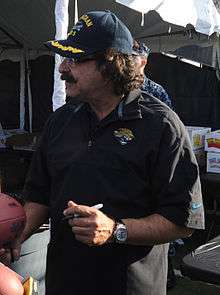
Immediately following the announcement of Del Rio being fired, Weaver also announced that the team would be sold to Illinois businessman Shahid Khan.[47][48] Khan's assumption of ownership was approved a couple of weeks later by the NFL team owners, and Khan took over full ownership on January 4, 2012. He immediately began the team's search for head coaching candidates.[49]
On February 13, 2012, the Jaguars hired MetLife Stadium president and CEO Mark Lamping as team president. Lamping also spent 13 years as the president of the St. Louis Cardinals. Lamping is the second team president in franchise history and the first since 1997, when David Seldin left that position.[50]
2012
On January 10, 2012, former Atlanta Falcons offensive coordinator Mike Mularkey was named head coach of the Jaguars. On January 13, it was announced that interim head coach Mel Tucker would remain on the staff as defensive coordinator/assistant head coach and that former Falcons quarterbacks coach Bob Bratkowski would become offensive coordinator.[51] On January 20, 2012, the team hired John Bonamego as special teams coordinator.
The Jaguars began the 2012 season with a new coaching staff and a new owner. One of the main priorities of the new leadership was to improve the team's struggling receiving corps and see improvement from quarterback Blaine Gabbert after a disappointing rookie season. To do this, the team selected wide receiver Justin Blackmon in the first round of the 2012 NFL Draft and acquired Laurent Robinson in free agency. Despite the changes, the team struggled mightily on both sides of the ball. The team finished with a 2–14 record, the worst in franchise history. Both general manager Gene Smith and head coach Mike Mularkey were fired shortly after the end of the season.[52]
NFL International Series
On August 21, 2012, the Jaguars announced they had finalized a deal to play one regular season home game each year between 2013 and 2016 at London's historic Wembley Stadium as part of the NFL International Series.[53] The first of these games was against the San Francisco 49ers on October 27, 2013.[54][55] This deal was later extended through 2020.[56]
2013–2016

On January 8, 2013, former Atlanta Falcons Director of Player Personnel David Caldwell was hired as the second full-time General Manager in Jaguars history.[57] He formerly served as a scout for the Indianapolis Colts for 10 years from 1998–2007. His first task with the team was to lead the interview process for a new head coach. Nine days later former Seattle Seahawks defensive coordinator Gus Bradley was named head coach of the Jaguars.[58] The Jaguars struggled early on in 2013 and went into the bye week with an 0–8 record. On November 1 Justin Blackmon was suspended indefinitely after violating the NFL's Policy and Program for Substances of Abuse.[59] Despite the loss of Blackmon the Jaguars got their first win with Gus Bradley on November 10 with a 29–27 victory over the Tennessee Titans. This was followed by a respectable showing against the Arizona Cardinals, despite a 27–14 loss, and the Jaguars' second and third victory of the season against the Houston Texans and the Cleveland Browns. The Jaguars would win again the very next week against the Houston Texans 27–20 on Thursday night, improving to 4–9. They finished the season 4–12.
2014–2015
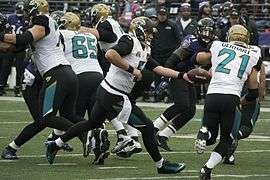
After finishing the 2013 season with a 4–12 record, a two-win improvement over the previous season, the Jaguars traded their 2011 NFL draft first round draft pick Blaine Gabbert to the San Francisco 49ers for the 6th round pick of the 2014 NFL draft.[60] Maurice Jones-Drew, after 7 years with the Jaguars, also left the team and signed a three-year contract with the Oakland Raiders.[61]
In the first round of the 2014 NFL draft the Jaguars selected quarterback Blake Bortles from University of Central Florida and then wide receiver Marqise Lee from University of Southern California in the second round. The new draft picks helped put more confidence in the struggling team.[62] Justin Blackmon was suspended yet again for violating the NFL's Policy and Program for Substances of Abuse in July.[63] Later in July, EverBank Field unveiled their two new endzone scoreboards, which are considered to be the world's largest.[64] The Jaguars managed to end their season with a 3–13 record.[65]
Dante Fowler Jr. was selected by the Jaguars as the third overall pick in the 2015 NFL draft.[66] However, Fowler tore his ACL at rookie minicamp on May 8 and did not return for the 2015 season.[67] Josh Scobee was traded to the Pittsburgh Steelers for a 2016 NFL Draft sixth round pick. Jason Myers took over as the main placekicker for the Jaguars.[68] The Jaguars finished the 2015 season with a record of 5–11, the team's fifth straight losing season and their eighth straight non-winning season.
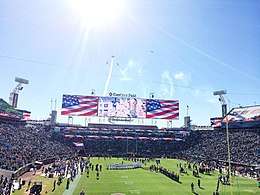
2016–2017
With plenty of cap space to work with, Jacksonville splurged in free agency, adding defensive tackle Malik Jackson from the Denver Broncos and cornerback Prince Amukamara from the New York Giants. With the fifth selection, the Jaguars selected cornerback Jalen Ramsey from Florida State University in the first round and then the second round linebacker Myles Jack of UCLA in the 2016 NFL Draft.[69] Jack was considered to be a top-10 talent, but fell to the second round due to a knee injury. On October 2, 2016, the Jacksonville Jaguars defeated the Indianapolis Colts 30–27 in the NFL International Series game.[70] On December 18, 2016, Gus Bradley was fired after the Jaguars' ninth loss in a row during the 2016 season. Bradley's W-L record as head coach of the Jaguars was 14–48 in three seasons.[71]
2017–present
On January 9, 2017 the Jaguars announced the interim head coach Doug Marrone was to be the new head coach, the contract of General Manager David Caldwell was to be extended and Tom Coughlin was returning to Jacksonville to become Executive Vice President of Football Operations. Both Doug Marrone and David Caldwell report to the Executive Vice President Tom Coughlin.[72]
In the first round of the 2017 NFL Draft the Jaguars selected running back Leonard Fournette of LSU.[73] At the annual NFL International Series in London on September 24, 2017 Jaguars players locked arms and kneeled during the national anthem in response to President Donald Trump's remarks on NFL players who kneel. Shahid Khan also participated with the Jaguars in locking arms during the anthem and the Baltimore Ravens kneeled on the opposite side of the field. The Jaguars went on to defeat the Ravens in a 44–7 win.[74] Four weeks later on October 17, President of the Jaguars Mark Lamping sent a letter of apology to the director of military affairs and veterans in Jacksonville that says the Jaguars were ”remiss in not fully comprehending the effect of the national anthem demonstration on foreign soil has had on the men and women who have or continue to serve our country.”[75]
After their week 15 win over the Houston Texans, the Jaguars clinched their first playoff appearance since 2007; they finished the season 10–6, enough to win the division for the first time since 1999. It was a seven-game turnaround from the previous year. The Jaguars defeated the Buffalo Bills 10–3 in Jacksonville, marking their first playoff win in ten years.[76] In the Divisional Round, on January 14, 2018, the Jaguars defeated the Pittsburgh Steelers 45–42 in Pittsburgh[77], their second win at Heinz Field that season, to advance to their 3rd AFC Championship Game, and their first in 18 years. After leading most of the game, they narrowly fell to the New England Patriots 24–20.[78] For the season, the defense earned the nickname "Sacksonville" because of its dominance.
In the first round of the 2018 NFL Draft the Jaguars selected defensive tackle Taven Bryan of University of Florida.[79]
Team colors, logos, and mascot
Logos
The day after the NFL awarded the expansion team to Jacksonville, a triumphant Wayne Weaver held up the Jaguars' proposed silver helmet and teal jersey at the NFL owners' meeting in Chicago. The team's colors were to be teal, gold, and silver with black accents. However, this jersey and helmet design, with a gold leaping jaguar, created controversy. Ford Motor Company, then-parent of the automaker Jaguar, believed that the Jaguars' logo bore too much resemblance to the automaker's logo. Though no lawsuit was brought to trial, lawyers from the team and the automaker negotiated an ultimately amicable agreement whereby Jaguar would be named the official car of the Jaguars, and the Jaguars would redesign their uniforms.
The new logo was a snarling jaguar head with a teal tongue, which Weaver said was his wife's touch. He also claimed that the teal tongue came from "feeding Panthers to our Jaguars" — an obvious jab at their expansion brethren. During the Jaguars' first ever preseason game teal-colored candies were handed out to all the fans who attended, turning their tongues a teal color just like on the logo. Additionally, raspberry lollipops were handed out by the "Candy Man" in section 142 to also turn the home fans' tongues teal.
In 2009, Weaver announced that he wanted to 'clean up' the team's image. This meant the elimination of the full-body crawling Jaguar logo, the clawing Jaguar, and the two previous wordmarks which bent the text around these logos.
In February 2013, Jaguars owner Shahid Khan, who had acquired the team in late 2011, introduced a new brand identity for the team that included a new logo, wordmark, and secondary logo. The new Jaguar head logo was intended to be "fiercer" and more realistic.[80] The secondary logo incorporated the new Jaguar head logo along with the first official usage of the team's popular nickname "Jags". The two images were incased in a shield-style shape, designed to be a tribute to Jacksonville's military community.[2]
Beginning in 2013, the Jaguars began to feature gold more prominently than in the past. In fact, from 2009–12 gold had only been used in the team logo and as a minor accent color.
Uniforms
For most of their history, the Jaguars have done what many other NFL teams located in subtropical climates traditionally practice: wear their white jerseys at home during the first half of the season — forcing opponents to wear their dark ones under the sweltering autumns in Jacksonville. The only exceptions were in 2004 and 2008–10, when the Jaguars chose to wear teal for all home games. In the preseason, the Jaguars typically wear teal at home since these games are played at night when there is very little advantage with the heat.
1995–2001
Following the logo change, the redesigned uniforms featured an all-black helmet, white pants with teal, black, and gold stripes, and numbers with gold inner trim and black outer trim. The home jersey was teal with white numbers and the away jersey was white with teal numbers. Both jerseys had a black collar and no sleeve stripes.
A prowling jaguar on each sleeve replaced the leaping jaguar going across both shoulders in the original design. The Jaguars in 1995 were the first NFL team to have 2-tone borders on their numbers and lettering, and the first NFL team to show a complex logo (the crawling Jaguar) on the sleeve.
Minor modifications were introduced to the Jaguars uniform during this time, most notably the font of the jersey numbers, replacing the original block numbers with a unique font. Two stripes were also added to the end of the sleeves below the prowling jaguar.
2002–2008
During this period, the Jaguars made minor changes to their uniform, each time adding more black to the look.
The team introduced a black alternate jersey in 2002. During that same year, the team also introduced alternate black pants, worn with either the white or the teal jersey. After the black pants were introduced, the white pants would only be seen for the first few games of the year, presumably due to the heat. The black pants originally included two teal stripes down each side. The fan reaction to the extra black in the alternate jersey and alternate pants was positive, so in 2004 the Jaguars went through a formal uniform change, which teams are only allowed to do once every five years. These changes were mostly to the away look. Before 2004, the white away jerseys had teal numbers with black and gold trim, but after, the white jerseys had black numbers with teal and gold trim. The black pants were also changed. The teal stripes were replaced with the Jaguar logo on each hip. Teal almost disappeared from the away uniform.
The stripes on the white pants were altered in 2008 so that the center, thickest stripe was black, and its accents were teal. In the 2008 year, the gold in the uniforms noticeably shifted from a bright yellow metallic appearance to more beige.
2009–2011
The Jaguars unveiled new uniforms for the 2009 season.[15][81] Team owner Wayne Weaver reportedly wanted to "clean up" the look, feeling that the team had too many uniform styles.[15] The new uniforms were introduced in a press conference on April 22.[82]
At this press conference, Weaver elaborated that different people had taken different liberties with the Jaguars' image over the years, singling out the 'All Black' look which the team wore for every prime-time home game from 2003 to 2007 as a point of regret. He also said that the team would wear their teal jerseys at home even on hot days, saying that the practice of choosing to wear white on hot days had also diluted the team's image. The new uniform reflected a simpler look overall. The collar and sleeve ends are the same color as the rest of the jersey. The crawling jaguar was removed. The numbers on the jerseys were changed to a simpler, block font with a thicker, single color border. After all of these subtractions, two features were added. The first was a "JAGUARS" wordmark underneath the NFL insignia on the chest. The second was two thin 'stripes' of off-color fabric which were added to each midseam of the jersey, curling up to the neckline on the front and below the number on the back. The stripe on the home jersey is a white line next to a black line, matching the color of the numbers, and the stripe on the away jersey is a black line next to a teal line, again matching the numbers. The pants have similar stripes, both for the home and away uniform. The away uniforms were still black pants and numbers on a white jersey, but they now used teal as the only accent color as opposed to using gold in previous years. The Jaguars' identity, in terms of colors, beginning in 2009 is exclusively teal and black, with gold only being used in the logo. The final change made to the Jaguars' uniforms in 2009 was to the helmet. The new helmet and facemask were black just like the old ones, but when light hit the new ones a certain way, both the helmet and face mask sparkled with a shiny teal appearance. These were the first helmets in professional football which changed color with different angles of light. The logo and number decals also incorporated this effect.[83]
2012
Prior to the 2012 season, new Jaguars owner Shahid Khan announced that the team would once again use a black jersey, something they had not done since 2008. In September of that year, the team announced that it would use the black jersey and black pants as their primary home uniform. The teal jersey was resurrected as an alternate.[84]
2013–2017
On April 23, 2013, the Jaguars unveiled new uniforms designed by Nike. The primary home jersey is black with white numerals outlined in teal and gold. The road jersey is white with teal numerals outlined in black and gold, marking the first time since 2003 that the team has used teal numbers on their road jersey. The alternate jersey is teal with black numerals outlined in white and gold. The team had never before used black numbers on their teal jersey. All three jerseys feature a contrasting stripe that bends around the neck, and semi-glossy patches on the shoulders meant to resemble claw marks. The team added their new shield logo onto a patch just above the player's heart, meant to pay tribute to Jacksonville's military heritage.[85]
The helmet, first of its kind in the NFL, featured a glossy gold finish in the back that fades to matte black in the front, via a color gradient.[86]
The new uniform set includes black and white pants with the Jaguars logo on the hip and a tri-color pattern down the player's leg.
In November 2015, as one of eight teams participating in Nike's "Color Rush" initiative for four games of Thursday Night Football during the 2015 season, Jacksonville introduced an all-gold second alternative uniform. The set features a gold jersey with black sleeves and black trim, as well as all gold pants. The white front and back numbers are lined in the teal accent color and bordered by black. The TV numbers on the shoulders are white with black bordering. The set also features gold undershirts and socks.[87]
2018
On April 19, 2018, the Jaguars again revealed re-designed uniforms. The new design returns to an all-black gloss helmet and removes many of the complicated details from the previous set. For the first time, there will be no borders at all on any of the jersey numbers. There are no stripes or team logo on the pants; only an NFL logo and a Nike logo, which is the first and only of its kind in the NFL. Like the 2009 uniform set, the only gold in the uniform set belongs to the Jaguar logo itself, and the block number font is not distinct from that used by other teams. The sleeve trim and collar trim are both a different color than the rest of the jersey, that and the solitary Jaguar logo are the only distinct markings on the jersey. For the first time, the sock has a teal stripe between the black and white. The black jersey is the primary, as it has been since 2012, and the teal is the alternate.[88][89]
Mascot
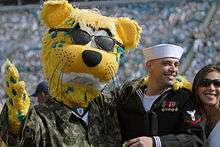
Since his introduction in 1996, Jaxson de Ville has served as the Jaguars' mascot. Jaxson entertains the crowd before and during games with his antics. The mascot has established a reputation for making dramatic entrances including bungee jumping off the stadium lights, sliding down a rope from the scoreboard and parachuting into the stadium.
Jaxson's antics got him into trouble in 1998 and stemmed the changing of the NFL's mascot rules, and also caused him to calm down.[90] However, Jaxson was still seen, by some, as a mascot that gets in the way during the game. After the October 22, 2007 game against Indianapolis, Colts President Bill Polian complained to the NFL, and Jaxson was reprimanded again.[91][92]
Jaxson's first appearance was on August 18, 1996[93] and was played by Curtis Dvorak from his inception until his retirement in June 2015.[94]
Jacksonville Roar
The Jacksonville Roar is the professional cheerleading squad of the Jaguars. The group was established in 1995, the team's inaugural year, and regularly performs choreographed routines during the team's home contests.[95]
In addition to performing at games and pep rallies, members function as goodwill ambassadors of the team, participating in corporate, community, and charitable events in the Jacksonville metropolitan area[96] where they sign autographs and pose for pictures. They also join NFL tours to entertain American servicemen and women around the world.[96][97]
Stadium
TIAA Bank Field (formerly known as Jacksonville Municipal Stadium, Alltel Stadium, and EverBank Field) is located on the north bank of the St. Johns River, and has been the home of the Jaguars since the team's first season in 1995. The stadium has a capacity of 69,132, with additional seating added during Florida–Georgia Game and the Gator Bowl.[98]
The stadium served as the site of Super Bowl XXXIX in addition to four Jaguar playoff games including the 1999 AFC Championship Game. It also hosted the ACC Championship Game from 2005–07 and the River City Showdown in 2007 and 2008.
From 1995–97 and again from 2006–09, the stadium was named Jacksonville Municipal Stadium. From 1997–2006, the stadium was referred to as Alltel Stadium.[99] The naming rights were purchased by EverBank prior to the 2010 season.[100] Prior to the 2018 season the Jaguars announced the stadium would be renamed TIAA Bank Field.[101]
The stadium got a substantial upgrade in 2014 with the addition of new scoreboards, pools, cabana seating and premium seating that includes 180 field-level seats. The scoreboards are 60 feet high and 362 feet long. The new scoreboards at TIAA Bank Field are now the world's largest video boards. Two 25 feet by 12 feet pools were installed in the north and south end zones along with the cabana seating. The stadium upgrades were $63 million that owner Shahid Khan helped finance $20 million of the total cost.[102]
Rivals
The Jacksonville Jaguars have three primary rivals: their divisional rivals (Tennessee Titans, Indianapolis Colts, and Houston Texans).[103] They have geographic rivalries with the Miami Dolphins and Tampa Bay Buccaneers. The Jaguars also have a rivalry with their 1995 expansion brethren, the Carolina Panthers. The Jaguars also have rivalries with other teams that arose from the AFC Central days, most notably with the Pittsburgh Steelers.[104]
Statistics and records
Season-by-season results
This is a partial list of the Jaguars' last five completed seasons. For the full season-by-season franchise results, see List of Jacksonville Jaguars seasons.
Note: The Finish, Wins, Losses, and Ties columns list regular season results and exclude any postseason play.
| Super Bowl champions (1970–present) | Conference champions | Division champions | Wild Card berth |
As of December 31, 2017
| Season | Team | League | Conference | Division | Regular season | Postseason results | Awards | |||
|---|---|---|---|---|---|---|---|---|---|---|
| Finish | Wins | Losses | Ties | |||||||
| 2013 | 2013 | NFL | AFC | South | 3rd | 4 | 12 | 0 | — | — |
| 2014 | 2014 | NFL | AFC | South | 3rd | 3 | 13 | 0 | — | — |
| 2015 | 2015 | NFL | AFC | South | 3rd | 5 | 11 | 0 | — | — |
| 2016 | 2016 | NFL | AFC | South | 4th | 3 | 13 | 0 | — | — |
| 2017 | 2017 | NFL | AFC | South | 1st | 10 | 6 | 0 | Won Wild Card Playoffs (Bills) 10–3 Won Divisional Playoffs (Steelers) 45–42 Lost AFC Championship Game (Patriots) 24–20 | — |
Current roster
Jacksonville Jaguars roster | |||||||||
|---|---|---|---|---|---|---|---|---|---|
| Quarterbacks
Running backs
Wide receivers
Tight ends
|
Offensive linemen
Defensive linemen
|
Linebackers
Defensive backs
Special teams
|
Reserve lists
Practice squad
Rookies in italics Roster updated October 16, 2018 | ||||||
Players of note
Retired numbers
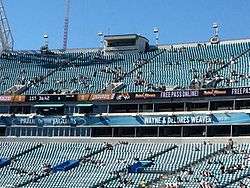
Although not officially retired, the number 71 worn by offensive tackle Tony Boselli, the Jaguars' first-ever draft pick, has not been worn since his retirement in 2002.[105] According to team officials, while the number is not in circulation, the number (along with Fred Taylor's number 28) is officially available for use if the circumstances warrant it.[106]
Pride of the Jaguars
A contest was held in July 2006 to name the club's ring of honor and "Pride of the Jaguars" was chosen with 36% of the vote.[107] It was unveiled during the 2006 season during a game against the New York Jets on October 8. Former offensive tackle Tony Boselli was the first player inducted.
On January 1, 2012, team owner Wayne Weaver and his wife Delores were added to the Pride of the Jaguars in their final game before the sale of the team to Shahid Khan. On June 7, 2012 the Jaguars announced Fred Taylor would be the next inductee into the Pride of the Jaguars.[108] He was officially inducted on September 30, 2012. Longtime Jaguars quarterback Mark Brunell was also inducted into the "Pride of the Jaguars" on December 15, 2013.[109]
| Pride of the Jaguars | ||||
|---|---|---|---|---|
| No. | Player | Position | Seasons | Inducted |
| 71 | Tony Boselli | OT | 1995–2001 | 2006 |
| — | Wayne and Delores Weaver | Owners | 1993–2011 | 2012 |
| 28 | Fred Taylor | RB | 1998–2008 | 2012 |
| 8 | Mark Brunell | QB | 1995–2003 | 2013 |
| 82 | Jimmy Smith | WR | 1995-2005 | 2016 |
Florida Sports Hall of Fame
All-time first-round draft picks
Head coaches and coordinators
Head coaches
Offensive coordinators
| Name | Tenure |
|---|---|
| Kevin Gilbride | 1995–1996 |
| Chris Palmer | 1997–1998 |
| Bobby Petrino | 2001 |
| Bill Musgrave | 2003–2004 |
| Carl Smith | 2005–2006 |
| Dirk Koetter | 2007–2011 |
| Bob Bratkowski | 2012 |
| Jedd Fisch | 2013–2014 |
| Greg Olson | 2015–2016 |
| Nathaniel Hackett | 2016–present |
Defensive coordinators
| Name | Tenure |
|---|---|
| Dick Jauron | 1995–1998 |
| Dom Capers | 1999–2000 |
| Gary Moeller | 2001 |
| John Pease | 2002 |
| Mike Smith | 2003–2007 |
| Gregg Williams | 2008 |
| Mel Tucker | 2009–2012 |
| Bob Babich | 2013–2015 |
| Todd Wash | 2016–present |
Current coaching staff
Jacksonville Jaguars staff | ||||||
|---|---|---|---|---|---|---|
|
→ Coaching staff | |||||
Work in the community

The Jacksonville Jaguars Foundation was established in 1994, when the franchise deal was first announced.[110] Since then, the Foundation has given over $20 million to area efforts in community improvement.[111] The Foundation focuses on many initiatives, such as Honor Rows, anti-tobacco programs, NFL Play 60, and support for veterans.[112] The Foundation grants over $1 million annually to organizations that assist "economically and socially disadvantaged youth and families".[113]
The Jaguars' first head coach, Tom Coughlin, established the Tom Coughlin Jay Fund Foundation in 1996 to help young cancer victims and their families with emotional and financial assistance. The charity remained in Jacksonville after Coughlin left to coach the New York Giants.[114]
Broadcast media
Radio
From their inaugural 1995 season until 2013, the Jaguars' flagship radio station was WOKV, which simulcasts on both AM 690 and on 104.5 FM.
Starting with the 2014 season, the team will be moving the broadcast to WJXL and WJXL-FM (1010 AM and 92.5 FM) and simulcast on 99.9 Gator Country[115]
Frank Frangie is the play-by-play announcer with former Jaguars players Tony Boselli and Jeff Lageman providing color analysis.
| Jaguars Radio network affiliates | ||||
|---|---|---|---|---|
| Market | Frequency | Call sign | Branding | |
| Jacksonville | 1010 AM & 92.5 FM | WJXL & WJXL-FM | 1010XL | |
| 99.9 | WGNE-FM | 99.9 Gator Country | ||
| St. Augustine | 1420 AM | WAOC | ESPN Radio 1420 | |
| Orlando | 1080 AM | WHOO | Sports Talk 1080 The Team | |
| Melbourne | 1240 AM | WMMB | New Talk WMMB | |
| Lake City | 94.3 FM | WNFB | Mix 94.3 | |
| Ocala | 900 AM | WMOP | ESPN Radio | |
| Port St. Lucie | 1590 AM | WPSL | 1590 WPSL | |
| Gainesville | 850 AM | WRUF | ESPN 850 | |
| Savannah, GA | 104.3 FM and 1400 AM | WSEG | Star 1400 | |
| Brunswick, GA | 107.7 FM | WHFX | 107.7 The Fox | |
| Jesup, GA | 105.5 FM | WIFO | Big Dog 105.5 Country | |
| Waycross, GA | 1150 AM | WJEM | The Jock 1150 | |
| Tallahassee | 93.3 FM | WVFT | Talk Radio 93.3 | |
| Panama City | 97.7 FM | WYYX | 97X | |
| Palm Coast | 1550 AM | WNZF | WNZF Newsradio | |
| Kingsland, GA | 106.3 FM | WKBX | KBAY 106.3 | |
Television
WJXT televises all preseason games and also televises regular season games that are televised nationally on ESPN or NFL Network.
| Television affiliates | ||
|---|---|---|
| Market | Station | Notes |
| Jacksonville | WJXT | Preseason games, ESPN and NFL Network regular season games |
| WJXX | Monday Night Football Wild Card simucasted on ABC | |
| WJAX-TV | CBS games | |
| WFOX-TV | Fox games | |
| WTLV | NBC games | |
| Orlando | WFTV | Preseason games |
| Tallahassee | WTXL-TV | Preseason games |
| Gainesville | WNBW-DT | Preseason and NBC games |
| Savannah, GA | WSAV-TV | Preseason and NBC games |
| Dothan, AL | WTVY | Preseason and CBS regional/national games |
| Panama City | WJHG-TV | Preseason and NBC games |
| Valdosta/Albany, GA | WSWG | Preseason and CBS regional/national Games |
| Charleston, SC | WTAT-TV | Preseason and Fox regional/national games |
| Mobile, AL-Pensacola | WPMI-TV | Preseason and NBC games |
See also
Notes and references
- ↑ Sexton, Brian (November 4, 2014). "Jaguars History". Jacksonville Jaguars. Archived from the original on November 6, 2014. Retrieved May 21, 2018.
- 1 2 Jaguars Public Relations (February 5, 2013). "Jaguars introduce new brand identity and campaign". Jacksonville Jaguars. Archived from the original on February 8, 2013. Retrieved May 21, 2018.
- ↑ "Jacksonville Jaguars Team Capsule" (PDF). 2018 Official National Football League Record and Fact Book. NFL Enterprises, LLC. August 9, 2018. Retrieved September 17, 2018.
- ↑ "Jacksonville Jaguars Team Encyclopedia". Pro-Football-Reference.com. Sports Reference LLC. Retrieved January 25, 2016.
- ↑ "Pakistani-born Khan approved as Jaguars' new owner". National Football League. Associated Press. December 14, 2011. Retrieved January 25, 2016.
- ↑ Ozanian, Mike (November 29, 2011). "Jacksonville Jaguars Sold To Illinois Businessman For $770 Million". Forbes. Retrieved January 25, 2016.
- ↑ Kurt Badenhausen. "Shahid Khan – Forbes". Forbes.
- 1 2 3 4 Frank Litsky (December 1, 1993). "PRO FOOTBALL; N.F.L. Expansion Surprise: Jacksonville Jaguars". The New York Times. Retrieved July 5, 2012.
- ↑ https://www.census.gov/population/www/cen2000/briefs/phc-t3/tables/tab01.txt
- ↑ https://www.census.gov/population/www/documentation/twps0027/tab22.txt
- ↑ "Alltel Stadium — BNI Engineers". BNIEngineers.com. Bliss & Nyitray, Inc. Retrieved May 10, 2016.
- ↑ Dame, Mike. "Gator Bowl moves to Gainesville for one year", South Florida Sun-Sentinel. January 28, 1994. Page C4.
- 1 2 Didinger, Ray (1996). Game Plans For Success. McGraw-Hill. p. 256. ISBN 0809231719.
- ↑ Sexton, Brian (February 15, 2015). "On This Day: Expansion Draft 1995". Jacksonville Jaguars. Archived from the original on February 17, 2015. Retrieved May 21, 2018.
- 1 2 3 "All Articles - jaguars.com". Retrieved 21 June 2016.
- ↑ "Thigpen Drops Crown On Packers' Heads". AP. 25 December 1995. Retrieved 21 June 2016 – via The New York Times.
- ↑ "Andersen's Miss Puts Jaguars in Postseason". Chicago Sun-Times. December 23, 1996. Retrieved 2007-11-05.
- ↑ Allan, Scott (2010-12-21). "Biggest playoff upsets in NFL history". Sports.yahoo.com. Retrieved 2012-09-03.
- ↑ On, Esteban (2012-01-10). "11 Biggest NFL Playoff Upsets". Totalprosports.com. Retrieved 2012-09-03.
- ↑ "NFL Top 5: Biggest playoff upsets". Covers.com. Retrieved 2012-09-03.
- ↑ "Stop talking about the 1996 season". Big Cat Country. October 19, 2015. Retrieved November 22, 2015.
- ↑ 1997 NFL season
- ↑ Team profile, pro-football-reference.com; accessed November 30, 2014.
- ↑ Ruppel, Chris (November 22, 2015). "New York Jets Throwback Thursday: Playoff Home Cookin'". Vox Media. Retrieved November 22, 2015.
- ↑ Fred Taylor historic 90 yard run, sportsillustrated.cnn.com, January 15, 2000; accessed November 30, 2014.
- ↑ Law, Zach (May 18, 2012). "Tennessee Titans Classic Games: 1999 AFC Championship vs. Jacksonville Jaguars". Bleacher Report. Retrieved November 22, 2015.
- ↑ Marvez, Alex. "Salary Cap Will Just Exacerbate Jags' Problems". Sun-Sentinel. Retrieved January 18, 2013.
- ↑ "History of the Wild Card". profootballhof.com. Retrieved November 22, 2015.
- ↑ "Josh Scobee". Jaguars.com. Jaguars. Archived from the original on 2015-10-05.
- ↑ "2004 Jacksonville Jaguars". pro-football-reference. Sports Reference LLC. Retrieved November 23, 2015.
- ↑ "Patriots throttle Jaguars as champs begin title defense". ESPN. January 8, 2006. Retrieved November 23, 2015.
- ↑ "2006 NFL Draft". pro-football-reference.com. Sports Reference LLC.
- ↑ "Expert picks: Cowboys, Chargers on collision course?". 28 August 2008. Retrieved 21 June 2016.
- ↑ News 4 Jax Archived November 26, 2009, at the Wayback Machine.
- ↑ "Fred Taylor Retires as a Member of the Jacksonville Jaguars". Archived from the original on 30 July 2012. Retrieved 5 January 2012.
- 1 2 3 4 Farmer, Sam (December 8, 2009). "Jaguars singing the small-market blues in Jacksonville". Los Angeles Times. Retrieved September 12, 2010.
- ↑ "2009 NFL Football Attendance". ESPN. Retrieved 22 January 2012.
- ↑ "Goodell: Jaguars' attendance "a concern"". news4jax.com. Associated Press. February 5, 2010. Archived from the original on February 9, 2010. Retrieved December 16, 2010.
- ↑ Anderson, Les (September 27, 2006). "A Solution, or Merely a Cover?". Washington Post. Retrieved December 16, 2010.
- ↑ Stellino, Vito (August 5, 2010). "Jaguars Notebook: Mayor John Peyton encourages fans to buy more tickets". The Florida Times-Union. Retrieved December 16, 2010.
- ↑ Stellino, Vito (August 2, 2010). "NFL commissioner Roger Goodell still has high hopes for Jaguars' future". The Florida Times-Union. Retrieved December 16, 2010.
- ↑ Mitchell, Tia (August 10, 2010). "Jaguars now have EverBank Field — and the city's $4 million". The Florida Times-Union. Retrieved September 12, 2010.
- ↑ Mike Florio (December 1, 2010). "Jaguars see dramatic spike in attendance". profootballtalk.nbcsports.com. Retrieved December 16, 2010.
- ↑ Jason Notte (December 10, 2010). "Jaguars Avoid NFL Blackout, Bills Face Third". TheStreet.com. Retrieved December 16, 2010.
- ↑ "Indianapolis vs. Jacksonville". cbssports.com. 2010. Retrieved December 16, 2010.
- ↑ "NFL Draft 2011". Sports Illustrated. Retrieved August 29, 2011.
- ↑ Mike Florio (November 29, 2011). "Del Rio out in Jacksonville". profootballtalk.nbcsports.com. NBC Sports. Retrieved November 29, 2011.
- ↑ Tania Ganguli (November 29, 2011). "Jaguars being sold, Jack Del Rio fired". The Florida Times-Union. Retrieved November 29, 2011.
- ↑ "Khan era begins". Jacksonville Jaguars. January 5, 2012. Archived from the original on January 9, 2012. Retrieved May 21, 2018.
- ↑ Ganguli, Tania. "Jaguars hire Mark Lamping as team president". jacksonville.com. Retrieved 2012-09-03.
- ↑ Oesher, John (January 14, 2012). "Tucker, Bratkowski named coordinators". Jacksonville Jaguars. Archived from the original on January 16, 2012. Retrieved May 21, 2018.
- ↑ Kuharsky, Paul. "Jaguars fire Mike Mularkey". ESPN.go.com. ESPN. Retrieved October 8, 2014.
- ↑ "Report: Jags to play games in London". espn.com. ESPN. Associated Press. August 21, 2012. Retrieved August 21, 2012.
- ↑ "Report: 49ers to play Jaguars in London". espn.com. ESPN. Associated Press. October 11, 2013. Retrieved October 11, 2013.
- ↑ "NFL to hold three games in London in 2014". firstcoastnews.com. 2013-10-08. Retrieved 2013-10-21.
- ↑ "NFL extends agreement to play regular-season games at Wembley Stadium for an additional five years". NFLUK. National Football League. Retrieved 26 October 2015.
- ↑ Oehser, John (January 8, 2013). "Caldwell named Jaguars General Manager". Jacksonville Jaguars. Archived from the original on January 11, 2013. Retrieved May 21, 2018.
- ↑ "Gus Bradley named head coach of Jaguars". Jacksonville Jaguars. January 18, 2013. Archived from the original on January 20, 2013. Retrieved May 21, 2018.
- ↑ Wesseling, Chris. "Jaguars' Justin Blackmon suspended, will miss season". NFL.com. NFL. Retrieved October 7, 2014.
- ↑ DiRocco, Michael. "QB Blaine Gabbert dealt to Niners". ESPN.go.com. ESPN. Retrieved October 7, 2014.
- ↑ Bien, Louis. "Maurice Jones-Drew signs with the Raiders, or: Another sign of hard times for running backs". sbnation.com. SB Nation. Retrieved October 7, 2014.
- ↑ Hornack, Ken. "After previous draft failures, Jaguars pin future to top picks Bortles, Lee, Robinson". Foxsports.com. Fox Sports. Retrieved October 7, 2014.
- ↑ Katzowitz, Josh. "Report: Justin Blackmon arrested for marijuana possession". CBSSports.com. CBS Sports. Retrieved October 7, 2014.
- ↑ Bibber, Ryan Van. "Jaguars unveil world's largest scoreboards at EverBank Field". SBNation.com. sbnation. Retrieved October 7, 2014.
- ↑ O'Halloran, Ryan. "Final drive stalls as Jaguars finish season 3–13 with loss to Houston". Jacksonville.com. Retrieved January 1, 2015.
- ↑ Sessler, Marc (April 30, 2015). "Jaguars select Dante Fowler Jr. with No. 3 overall pick". NFL. Retrieved September 20, 2015.
- ↑ Daniels, Tim (May 8, 2015). "Dante Fowler Jr. Injury: Updates on Jaguars DE's Knee and Return". Bleacher Report. Retrieved September 20, 2015.
- ↑ DiRocco, Mike (August 31, 2015). "Jaguars trade kicker Josh Scobee to Steelers". ESPN. Retrieved 21 November 2016.
- ↑ Brinson, Will (April 30, 2016). "2016 NFL Draft: Jaguars win with big D additions, Eagles empty-handed". CBS Sports. Retrieved 1 May 2016.
- ↑ "Jaguars 30-27 Colts: NFL Wembley win for Jacksonville as Blake Bortles stars". BBC. October 2, 2016. Retrieved 17 October 2016.
- ↑ Rosenthal, Gregg (December 18, 2016). "Gus Bradley fired by Jacksonville Jaguars". National Football League. Retrieved December 19, 2016.
- ↑ Oehser, John (January 9, 2017). "Doug Marrone new head coach; Tom Coughlin returns". Jacksonville Jaguars. Archived from the original on January 10, 2017. Retrieved May 21, 2018.
- ↑ "Jaguars select RB Leonard Fournette with No. 4 pick in NFL draft". USA Today. April 27, 2017. Retrieved 28 April 2017.
- ↑ "Trump NFL row: Defiance after US president urges boycott". BBC. September 24, 2017. Retrieved 24 September 2017.
- ↑ Wagner-McGough, Sean. "Jaguars president apologizes for kneeling during national anthem in London". CBS Sports. Retrieved 13 November 2017.
- ↑ DiRocco, Michael (January 7, 2018). "Jaguars survive Bills -- and Blake Bortles, the passer -- for first playoff win since '07 season". ESPN. Retrieved 7 January 2018.
- ↑ Reyes, Lorenzo (January 14, 2018). "Jaguars handle Steelers, crash AFC Championship Game party". USA Today. Retrieved January 24, 2018.
- ↑ "Patriots rally late, end Jaguars' season in AFC title game". The Florida Times-Union. January 21, 2018. Retrieved 2018-01-25.
- ↑ Zucker, Joseph (April 26, 2018). "Jaguars Grab Taven Bryan in 2018 NFL Draft and Twitter Loves the Pick". Bleacher Report. Retrieved 27 April 2018.
- ↑ Oehser, John (February 6, 2013). "A new logo for a new era". Jacksonville Jaguars. Archived from the original on February 8, 2013. Retrieved May 21, 2018.
- ↑ "AFC South". Retrieved 21 June 2016.
- ↑ Ketchman, Vic (April 9, 2009). "Another Fred Taylor?". Jaguars.com. Retrieved November 30, 2014.
- ↑ "Jaguars continue their offseason overhaul with new uniforms, logo". NFL.com. NFL Enterprises, LLC. November 23, 2015. Retrieved November 23, 2015.
- ↑ Jaguars Public Relations (September 27, 2012). "Teal to become Jaguars' alternate jersey". Jacksonville Jaguars. Archived from the original on October 1, 2012. Retrieved May 21, 2018.
- ↑ Jaguars Public Relations (April 23, 2013). "Jacksonville Jaguars and NIKE Unveil New Uniform Design for 2013" (Press release). Jacksonville Jaguars. Archived from the original on April 25, 2013. Retrieved May 21, 2018.
- ↑ Sessler, Marc (April 23, 2013). "Jacksonville Jaguars unveil their new team uniforms". NFL.com. NFL Enterprises, LLC. Retrieved April 24, 2013.
- ↑ "Color Rush: Four Games. Eight Teams. A Bold New Look for Thursday Night". Nike.com. 2015. Retrieved 2015-11-17.
- ↑ Jaguars Public Relations (April 19, 2018). "Jaguars unveil new Nike Vapor Untouchable uniforms". Jacksonville Jaguars. Retrieved September 17, 2018.
- ↑ Shook, Nick (April 19, 2018). "Jacksonville Jaguars unveil new old-school look". NFL.com. NFL Enterprises, LLC. Retrieved August 7, 2018.
- ↑ Jacksonville.com (1999). "Jaxson De Villain". Jacksonville.com. Retrieved 2007-09-29.
- ↑ Michael David Smith (2007). "Jaguars Mascot Jaxson de Ville Draws Ire of Colts President Bill Polian". sports.aol.com. Retrieved 2007-11-18.
- ↑ Fox 30 Online (2007). "Jaguars Mascot Busted For Not Following Rules". Fox30.online.com. Retrieved 2007-11-18.
- ↑ Teneshia L. Wright (2001). "Alltales: "Singer's Streak Hits Seven"". Jacksonville.com. Retrieved 2007-09-29.
- ↑ Jaguars Press Release (2001). "Jaxson de Ville, the ROAR to Travel to Middle East to Visit U.S. Armed Forces". Jaguars.com. Retrieved 2007-09-29.
- ↑ "Jacksonville Roar" Football Babble
- 1 2 "Cheerleader Auditions" Jacksonville Jaguars website
- ↑ "Jaxson de Ville, the ROAR to Travel to Middle East to Visit U.S. Armed Forces", jaguars.com (Jaguars Press Release; 2001)
- ↑ "Jaguars Notebook". Jacksonville.com. August 10, 2004. Retrieved September 3, 2012.
- ↑ "City's take from stadium will go up". Jacksonville.com. September 8, 2007. Retrieved September 3, 2012.
- ↑ "EverBank buying naming rights to Jacksonville Municipal Stadium".
- ↑ Heilman, Phillip (16 February 2018). "New name for Jaguars' stadium: TIAA Bank Field". Jacksonville.com. Retrieved 17 February 2018.
- ↑ DiRocco, Michael. "Jaguars unveil mammoth video boards". ESPN.go.com. ESPN. Retrieved October 8, 2014.
- ↑ Kuharsky, Paul. "Best divisional rivalry: Jaguars vs. Titans – AFC South Blog – ESPN". Espn.go.com. Retrieved 2012-09-03.
- ↑ Bouchette, Ed (September 17, 2006). "Steelers-Jaguars rivalry born of inspiration and emulation". Pittsburgh Post-Gazette.
- ↑ "2013 NFL Record and Fact Book". Retrieved 2017-11-03.
- ↑ http://www.jaguars.com/news/article-JaguarsNews/2013-NFL-Record-and-Fact-Book/9175294f-cd24-4231-b003-cb3c9bb2bbce
- ↑ "'Honor ring' named". Jaguars.com. July 17, 2006. Retrieved July 5, 2012.
- ↑ Oehser, John (June 7, 2012). "A special moment". Jaguars.com. Retrieved June 7, 2012.
- ↑ Oehser, John. "Brunell to enter Pride of the Jaguars". Jaguars.com. Jaguars.
- ↑ "Jaguars Foundation - Jaguars.com". Retrieved 9 October 2012.
- ↑ "Weavers select 38 charities for grants". Jacksonville.com. June 23, 2007. Retrieved September 3, 2012.
- ↑ "Jaguars Media Guide – Foundation" (PDF). Retrieved 9 October 2012.
- ↑ "Jaguars Foundation". Jaguars.com. Jaguars. Retrieved November 23, 2015.
- ↑ "Tom Coughlin Jay Fund – Leadership". Tom Coughlin Jay Fund Foundation. Archived from the original on 2016-09-27.
- ↑ "It's official: Jaguars change stations on radio, TV". The Florida Times-Union. March 19, 2014. Retrieved 2018-01-25.
External links
| Wikimedia Commons has media related to Jacksonville Jaguars. |





